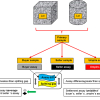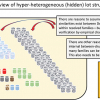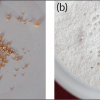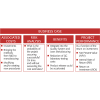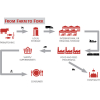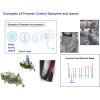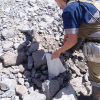Sampling Columns
In this issue, you will also learn something of the history of Danish medieval stone churches in northern and western Jutland! “Danish geology icon Arne Noe-Nygaard picks up on an 800 years old sampling and invents the Replication Experiment: PAT in disguise” is firmly rooted in the Theory of Sampling but you will also learn some geology and history!
The Assay Exchange paradigm is an integral element in many contractual agreements stipulating how business transactions rely on comparison of two independent assay results for commercial trading purposes. It turns out that the current Assay Exchange vs splitting gap comparison paradigm incurs no less than two unrecognised sampling uncertainties, which leads to hidden adverse economic consequences at least for one—and sometimes for both contractual parties. The magnitude of this unnecessary uncertainty is never estimated, which leaves management without information about potential economic losses, a breach of due diligence. However, all that is needed to resolve this critical issue is stringent adherence to the Theory of Sampling (TOS) by mandatory contractual stipulations of only accepting representative sampling and sub-sampling principles.
Kim Esbensen and Claudia Paoletti hope that a risk assessment scope will provide the sampling community with an easier, and perhaps more powerful, way to reach out to business, commerce, trade as well as regulatory and law-enforcement authorities across many societal sectors. It may also speak a more business-oriented language beyond traditional “TOS technicalities”.
“Error” and “uncertainty” are being used interchangeably and confusingly. This is “a scientific flaw of the first order”! However, Kim and Francis will put you right.
Sampling and Vikings seems to be the next unexpected connection within Kim Esbensen’s Sampling Column. Kim has been exploring an area of Southern Norway from where the founder of the Theory of Sampling, Pierre Gy, believed his ancestors originated. You will have to read the column to find the “smoking axe”! Oh, and there is an interesting report on the 10th World Conference on Sampling and Blending.
This column has invited two world-renowned experts in near infrared (NIR) spectroscopy to let the world benefit from decades of leading-edge experience, especially regarding sampling for quantitative NIR analysis.
Sampling is nothing more than the practical application of statistics. If statistics were not available, then one would have to sample every portion of an entire population to determine one or more parameters of interest. There are many potential statistical tests that could be employed in sampling, but many statistical tests are useful only if certain assumptions about the population are valid. Prior to any sampling event, the operative Decision Unit (DU) must be established. The Decision Unit is the material object that an analytical result makes inference to. In many cases, there is more than one Decision Unit in a population. A lot is a collection (population) of individual Decision Units that will be treated as a whole (accepted or rejected), depending on the analytical results for individual Decision Units. The application of the Theory of Sampling (TOS) is critical for sampling the material within a Decision Unit. However, knowledge of the analytical concentration of interest within a Decision Unit may not provide information on unsampled Decision Units; especially for a hyper-heterogenous lot where a Decision Unit can be of a completely different characteristic than an adjacent Decision Unit. In cases where every Decision Unit cannot be sampled, application of non-parametric statistics can be used to make inference from sampled Decision Units to Decision Units that are not sampled. The combination of the TOS for sampling of individual Decision Units along with non-parametric statistics offers the best possible inference for situations where there are more Decision Units than can practically be sampled.
Kim Esbensen, along with Dick Minnitt and Simon Dominy, tackle the ever-present dangers in sub-sampling; in this case in the assaying lab of mining companies.
Getting your sampling right can hardly be more important than in the nuclear waste industry. This column describes how the Belgian nuclear waste processing has benefited from the Theory of Sampling, and how it has led to important insights leading to significant potential improvements in the field of radioactive waste characterisation.
A Special Section dedicated to examing the “Economic arguments for representative sampling” with contributions from over 20 representative sampling experts.
Rodolfo J. Romañach
Department of Chemistry, University of Puerto Rico at Mayagüez
Editor’s summary
Sampling can be seen from many viewpoints: technical, economical, managerial… Here, sampling is described as a critical success factor in business cases, broadening the viewpoints presented above and below.
Trevor Brucea and Richard C.A. Minnittb
aFLSmidth, Boksburg East, 1459, South Africa
bVisiting Emeritus Professor, University of the Witwatersrand, Johannesburg, South Africa
DOI: https://doi.org/10.1255/sew.2021.a45
© 2021 The Author
Published under a Creative Commons BY-NC-ND licence
Melissa C. Gouws
InnoVenton, Nelson Mandela University, Gqeberha (Port Elizabeth), South Africa
Claudia Paoletti
Program Manager, Transformation Unit - TS, European Food Safety Authority – EFSA, Via Carlo Magno 1/A, 43100 Parma, Italy
Philippe Davin
Sales Manager, Bulk Solids DPT, Iteca Socadei, Aix-en-Provence, France
Dominique François-Bongarçon
Agoratek International Consultants, Inc.
Introduction
The objective of this contribution is not to add to an already large list of horror examples of hidden economic losses, but rather to raise a cry of alarm about what is experienced as a classical denial of cost-consequential sampling recommendations. A couple of real-world examples borrowed from the mining industry will almost tell the story by themselves.
Oscar Dominguez
Global Principal Geoscientist QAQC, Resource Centre of Excellence, BHP
D. Aldwin Vogel
Technical & Quality Director, Commodities Global Service Lines, Bureau Veritas, Rotterdam, the Netherlands

Simon Dominy
Camborne School of Mines, Cornwall, UK and Novo Resources Corporation, Perth, Western Australia
Gold segregation in pulps
An underground narrow gold vein (1–2 m width) operation was known to contain coarse gold particles up to 1.2 mm in size, and rarely up to 4 mm. The vein had an average global reserve grade of 17 g/t Au. Monthly reconciliations were up to ±50 % on grade.
Chris Robben
SIX-S GmbH, Hinter der Kirche 1A, 22880 Wedel, Germany
This example originates from the mining industry with some parallels to the previous exploration example.


